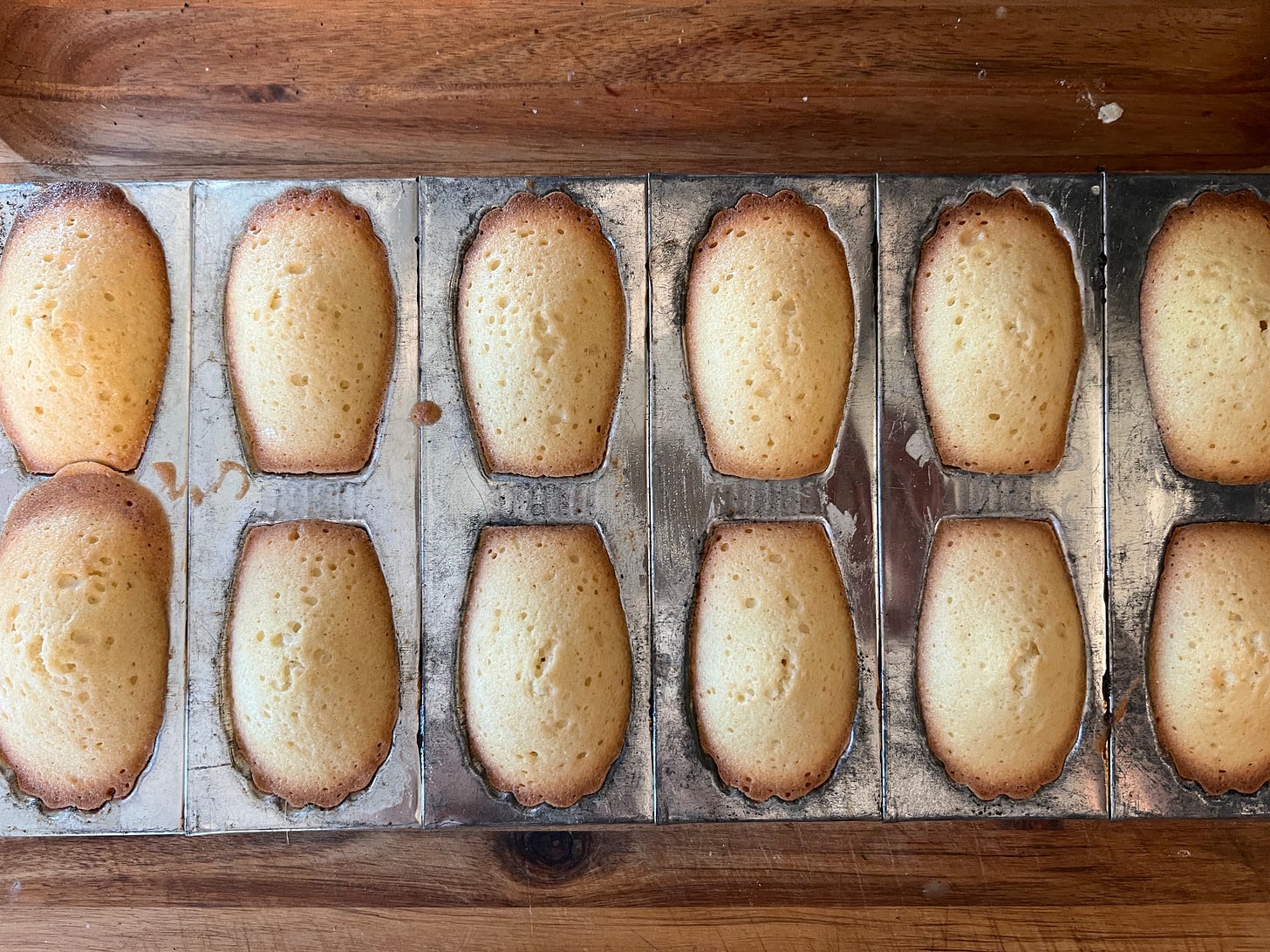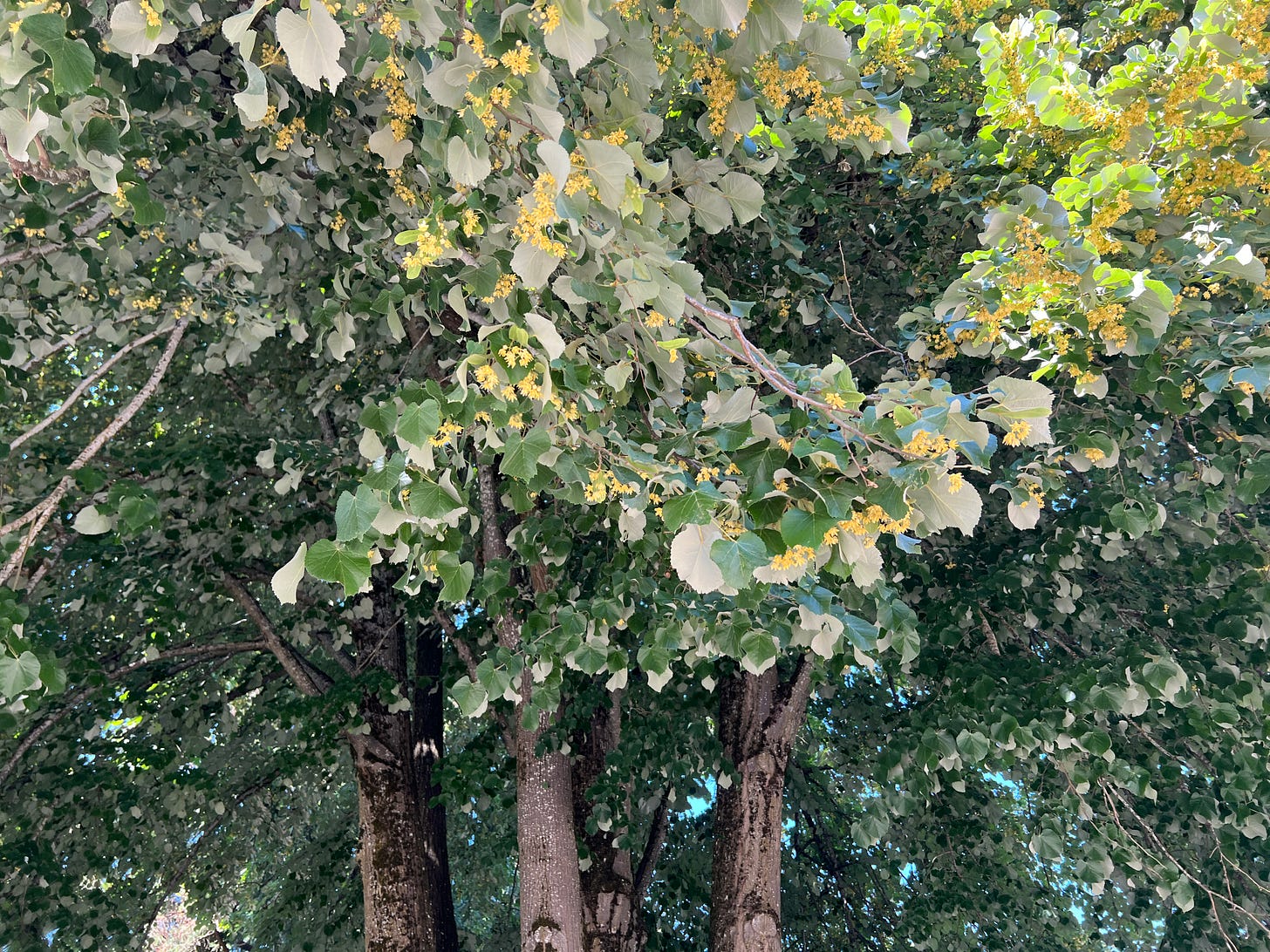Ten days ago, after a rainy June delayed their arrival, the lindens finally bloomed.
The first June we spent in Portland, I was riding my bike past Peninsula Park and passed through a cloud of dense, sugary perfume. I braked immediately. Clusters of cream-colored flowers had erupted all the way up to the tops of the 30-foot linden trees that flank Ainsworth Street, and in the weeks after, I would ride my bike to the park every other day just to wallow in the fragrance. Now, starting mid-June, I drive by the park with the car windows down, peering at the canopy, anticipating the return of linden season. To me, it signals that high summer, and the hot months, have finally arrived.
I don't quite know why my love for linden flowers is as greedy as it is. Delicate and innocent-smelling from a block or two away, the scent does recall the Love's Baby Soft perfumes my classmates wore in junior high. When I stand under the trees, nose tilted treeward, taking in deep yoga-class breaths, the aroma intensifies into something more feral, more fae, but not quite cloying. The scent dissipates long before I tire of it, and then I have to wait 50 weeks to smell it again.
This spring, I pledged that I'd pick enough flowers to make linden-blossom tea so I could finally recreate one of the most celebrated passages from Marcel Proust's Remembrance of Things Past and one of the most exhausted clichés in food writing. (If you have a few few minutes, here's the passage in English.)
In my early 20s, I made it halfway through the seven-volume Remembrance, reading half in French, half in English, and in the case of Du côté de chez Swann, once in both languages. It was part of my years-long quest to read every queer novel ever written, a search for myself in the fiction I devoured so catholically—a queering of my own imagination, if you will. In that regard, Remembrance was a disappointment, and I was a little weary of Proust by the time he revealed the extent of gay roué Baron de Charlus’s scandalous tastes. I was too young to recognize that queerness was infused into every line of the book: its lilting prose, its sly snobbery, its deep-diving introversion. I loved Proust a little. I resented him a little. I was him for the wrong reasons.
I stopped reading, but did remain curious about the shell-shaped cakes Proust mentions in the opening. The dispirited narrator, tasting failure on the cusp of middle age, dips a madeleine that his Aunt Léonie gives him into a cup of tisane de tilleul. The flavor of the old-fashioned treat resonates through his subconscious, reviving something in him that had been withering away. As he scans the surface of his conscious memories, trying to figure out what the madeleine and tisane have evoked, a swell of memory and emotion rises up from the depths, so vast that it takes him 17 years and seven volumes to capture in prose.
If Thierry Marx and Bernard Thomasson's French culinary history podcast is to be believed, shell-shaped madeleines flavored with brown butter and lemon zest originated in Commercy, a town in Lorraine, in the 1700s. They may have remained a regional novelty had Proust not canonized them. (In the States, Williams Sonoma and Sur La Table are most likely responsible for the madeleine pans that linger at the back of so many closets — thanks, Loree, for sharing yours with me.) The English translation of tisane de tilleul is "lime-flower," and so I spent decades imagining how citrus blossom-tea would taste, until I decided to re-read the passage in French before citing Proustian nostalgia in an article—I'm as guilty of perpetuating the cliché as every other food writer. I realized that I'd been missing out on linden-blossom tea all this time.
Rather than bring a step stool and clippers to a public park and risk death by Pacific Northwest side-eye, I posted a notice to my neighborhood Facebook Buy Nothing group, and a woman who lives three blocks away invited me over. Pamela has a massive, five-trunk linden that may date back to the construction of her century-old house. Last year, she learned about linden-blossom tree when a Turkish neighbor asked her if he could pick some to make a favorite drink from his own childhood. The blossoms on her tree were so dense that it only took us 15 minutes to snip off a few branches, and then an hour to lay the flowers on dehydrator trays—enough to make pots and pots of tisane de tilleul.
This morning, in the cool hours before high summer’s 100-degree temperatures hit, I baked a batch of Julia Child's madeleines, placed a cluster of dried flowers into a lidded cup, and poured boiling water over them to steep. Brewed into a tisane, the lindens’ floral perfume I love so much faded into straw and honey, blooming again on the lips after I sipped. Following Proust, I "raised to my lips a spoonful of the tea in which I had soaked a morsel of the cake."
Then I waited to see what would happen.
Food writers can be exasperatingly concrete, don't you think? Here I was, re-reading one of the most eloquent depictions ever written of the ways in which our senses inscribe our memories into our bodies, and all I wanted to know is: Well, is it tasty?
I leave it up to you to plumb your own subconscious with a cookie and a glass of tea. I have a giant jar of tisane de tilleul to share, extra madeleines to deliver to a friend, and a walk to the park to embark on before the last linden flowers shrivel on the trees, their marvelous perfume exhausted for yet another year.









Brat! So how did it taste? ;)
This made me laugh so hard: "...risk death by Pacific Northwest side-eye". LOL! Alas, take my advice and do NOT go climbing on stools grabbing for things above your head without help or else, you too many be wearing a chunky boot. xoxo